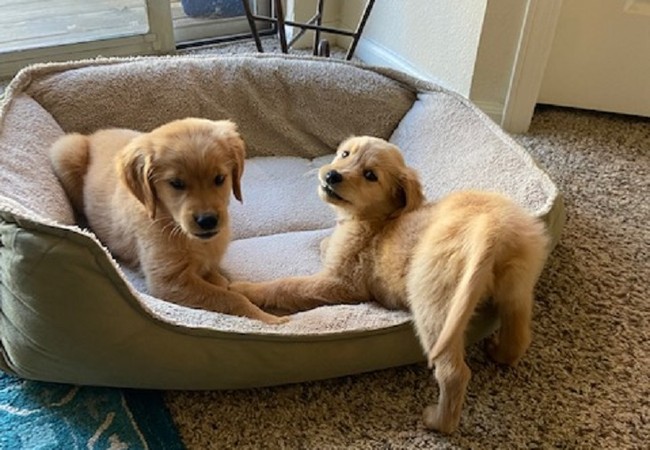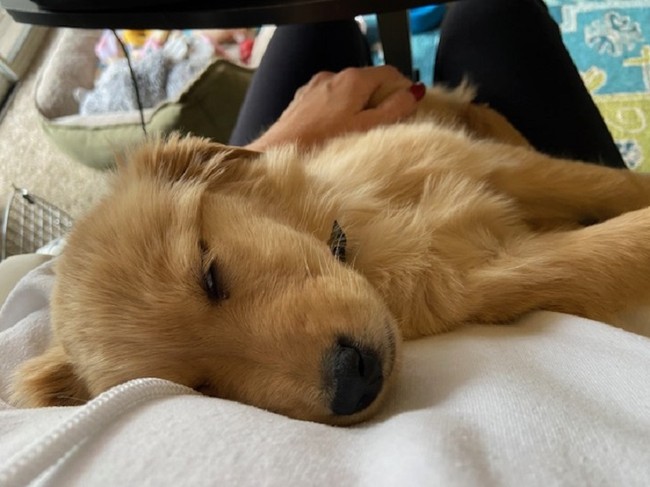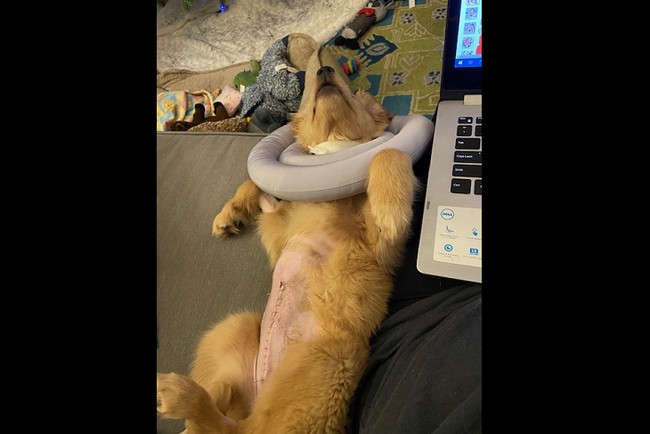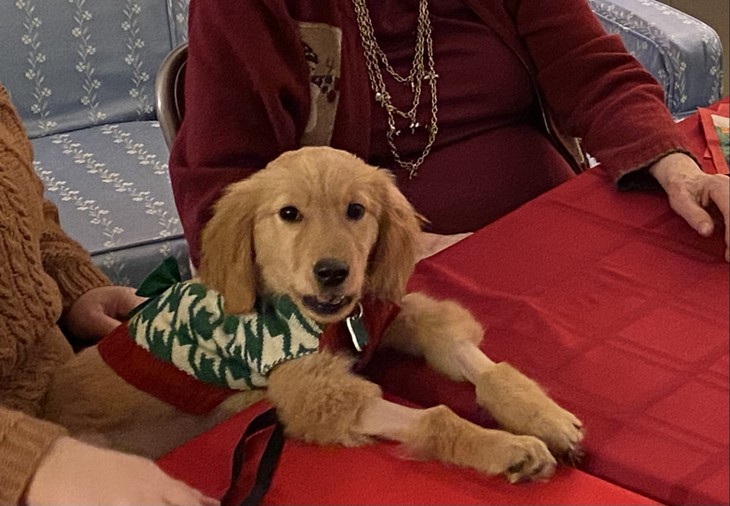Anyone who’s read some of my more personal entries or who follows my social media is likely aware that I’m a dog lover — animal lover, really, but dogs, in particular, hold a dear place in my heart. The loss of my beloved Golden Retriever Pringle three years ago was heartbreaking. I knew I wasn’t ready for another dog at that point. I was still working long hours in a busy law practice, focused on getting my daughter through her senior year of high school and off to college (amid COVID), and I needed time to grieve and regroup.
I wanted to do something to honor Pringle’s memory, so volunteering with the rescue organization from whence I’d adopted him made perfect sense. Early in 2020 began my once-a-week, early Saturday morning treks to Pacific, Missouri to tend to the resident pups at our shelter. Typically, the shelter hosts between 12 and 14 adult, large-breed, rescue dogs. They come to us as retired breeders, owner-surrenders, or sometimes strays that someone familiar with the organization has passed along to us. They’re fully vetted, spayed/neutered (if not already), and assessed for their temperament and the type of household that would be the best fit for them before being made available for adoption. On any given Saturday, my early morning shift (working with one or two other volunteers) includes getting them all outside to potty, feeding them, cleaning out their indoor kennels, exercising them a bit, and seeing that any related needs are tended to — it’s hard work, but rewarding in multiple ways, not least of which are the tail wags, snoofs, and sloppy kisses from our happy charges.
I’ve often had friends ask how I managed to not bring one home with me and the answer was simple: I wasn’t ready. I got plenty of quality doggy time on a weekly basis, and when I left, I no longer had to worry about the feeding and pottying and fur everywhere, or where to kennel a pup if I needed to travel. It was close to the best of both worlds. Other than not having a beloved four-legged companion of my own. I knew the time would come — just not yet.
As I mentioned, the rescue is for adult dogs, so puppies as charges are a rarity. We had three Great Pyrenees pups a couple of years ago who were about the cutest things I’d ever seen. I loved tending to them, and fell madly in love with the little girl pup, but as reluctant as I was to get another dog, I knew a puppy was out of the question. I adopted Pringle when he was two and God bless that dog, he was fully housebroken and a non-chewer, and about the lowest-maintenance dog anyone — particularly someone with my work schedule and lifestyle — could ever ask for. He spoiled me, to be honest.
Then, in late October of this year, the call went out for volunteers to help foster a pair of eight-week-old female Golden Retriever puppies. I’m not sure what prompted me to pipe up, but I made a half-hearted, “Oh, I wish I could,” sort of comment. Next thing I knew, “Princess” and “Buttercup” were in my charge — and my world was turned utterly upside down. I knew puppies were a lot of work, but now that I was working from home, I figured I could muddle through it — well, I did muddle through it, but it wasn’t pretty.

Buttercup was a mighty bundle of fur and fury — complete with a crinkled brow that signaled she was about to behave in an extra-puppyish way. And could that girl yap. Princess was the quieter pup — still playful, but smaller and not prone to barking much. She much preferred curling up at my feet or in my lap. There were moments in those first few days when I was certain I was going to lose my mind. That I got any sleep at all seemed a minor miracle. And I couldn’t have gotten through it without assists from several friends, particularly my dear friend Heather, who’s also my neighbor. She was a lifesaver, helping with taking the pups out to potty and keeping them entertained.
It became apparent fairly quickly that the gastrointestinal issues plaguing both pups initially had resolved for Butters but not so much for the Princess. And as Butters grew — seemingly overnight — Princess remained petite. I’d take them outside carrying each under an arm in a sort of football carry. Within a few days, the Buttercup arm was noticeably heavier than the Princess arm. The volunteer who’d arranged for my fostering had gently inquired as to my interest in potentially adopting one — though I resisted initially, I had to acknowledge that Princess was winning me over with her sweet, snuggly ways, though I was concerned about her ongoing tummy problems.

After about a week and a half, I waved the white flag on continuing to tend to both and was relieved to hand Buttercup off to another volunteer/foster family who had a couple of adult dogs (which I suspected would help with her learning how to dog). Now I could turn my full attention to Princess (whom I’d taken to calling “Daisy,” as I couldn’t quite make peace with the idea of a pup with such a precious, little-dog-sounding name). That first night without her sister, she, of course, wasn’t content to sleep in the dog bed (a Pringle hand-me-down) they’d both occupied. I’m a sucker, so she wound up snuggling with me in my bed. She’d curl up in a little ball next to my neck/shoulder and place a little paw on my arm and her puppy nose in the crook of my neck. Surprisingly, we both got a decent amount of sleep that way.
We made numerous trips to the animal hospital located near the shelter. They partner with the shelter and handle the vetting needs of our charges. We put Daisy on special food designed to address GI issues, but they persisted. Lots of tests were run. At one point, the working theory was that she had a liver shunt — a condition where abnormal blood vessels bypass the liver and return blood to circulation without the benefit of delivering critical hormones to/through the liver and filtering toxins out. The result is a pup with stunted growth, vomiting/diarrhea, and lethargy. It can be corrected with surgery and sometimes medically managed, but certainly not ideal. Further testing ruled that out, though. Then the theory was perhaps Addison’s Disease/ adrenal insufficiency. Her initial positive response to steroids gave us hope that was it, but that soon wore off and we were back to scratching our heads.
In the meantime, Daisy was starting to deteriorate. Though I’d committed to adopting her, that was put on hold while we sorted out her health issues. I saw a cute little Christmas sweater that I couldn’t resist buying for her, and then I wondered if that might have been overly optimistic. We were in mid-December and she was getting sicker and we still didn’t have a good answer as to what was going on with her. I could get her to eat, but she was showing less and less interest in it, and she was like a little rag doll missing some of its stuffing. One night, she paced and cried most of the night — and I cried too, so frustrated I didn’t know what to do to help her. (I should note, at this point, she was 15 weeks old and only weighed about 7.5 pounds — her sister weighed almost three times that.)
Finally, it was agreed we’d take her for a second opinion/consult at the University of Missouri’s Veterinary Clinic. They’re the best in the state and if anyone could help her, they could. She spent the day before at the animal hospital where she’d been receiving care. The man who founded the rescue organization paid her a visit and got a sense of what a sweet, adorable pup she was — that may have saved her life.

The next day, I drove to the animal hospital and picked up a weak and subdued Daisy and took her up to Columbia. Once there, some additional preliminary tests were run to confirm she didn’t have parvo — she didn’t. The veterinary ER doc came in and assessed her and confirmed that all the tests run to date had been the proper protocol and ruled out potential external causes for her GI issues. The next step would be to run an ultrasound and see what that revealed. I left her in their care and traveled back to St. Louis, as there was no guarantee as to how long the additional assessments would take. That afternoon, the doc called with some news: The ultrasound revealed she had an intestinal intussusception, also called a “telescoping bowel.” Basically, the end of her small intestine was sliding into her large intestine. This blocks food and fluid from passing through and cuts off the blood supply to the affected section — it’s not good. Daisy would need emergency surgery or to be euthanized.
It wasn’t my call to make — I was her “foster mom.” The decision would have to come from the rescue organization. Not an easy call to make, given the cost estimate of the surgery. They have numerous dogs’ needs to meet. The initial instinct was to proceed with the surgery. However, I then spoke with the surgeon and she was, understandably, not terribly optimistic. Daisy was weak and might not survive the surgery, to begin with. Even if she did, this condition can often recur. And the odds were that the condition itself wasn’t the initiating cause of her issues, but rather an effect of them. In other words, even if she survived the surgery and it held, she’d likely still have the underlying GI problems.
We had to give it additional thought. The founder’s call had been to proceed with the surgery — and I believe that was prompted in no small part by his having met the adorable ragamuffin — but that was before the frank discussion with the surgeon. We were on the fence and there were no easy answers. Ultimately, we opted to at least give her a chance. The surgery would go forward.
I braced myself for a call with grim news. I tried to distract myself with work. I looked at the Christmas sweater I’d bought for her and contemplated returning it, along with some of the other unused pet supplies I’d recently picked up.
The surgeon called around 7:50 pm — Daisy had made it through the surgery, though a transfusion was needed to stabilize her. They removed the section of the small intestine that was involved — the ilium — and would send it off for histopathology. She handled the anesthesia well and was resting comfortably. The call the next morning was even more encouraging: Daisy was doing great and had even begun chowing down food that night after the surgery. In fact, she was doing so well, they were ready to discharge her to my care. So back to Columbia I went to pick up the miracle pup.
She had shaved little patches of leg where they’d had to place IVs, and a shaved and stitched belly, and looked like she’d been through it. That sweet little pup curled up and slept in the passenger seat the whole way home, with an obnoxious cone on her head, and nary a peep. I petted her and told her how glad I was to see her and what a good girl she was.
It didn’t take long before Miss Daisy was chowing down food — at first, she was picky, partial to chicken and rice, but she soon graduated back to kibble with the chicken as an added (but not necessary) bonus. And thankfully, we were able to secure a donut collar for her rather than a plastic one — she didn’t seem to mind the donut much. Truthfully, she didn’t display much interest in the incision — though she was quite the sight. I took to calling her “Princess Daisy Frankenbelly.” (Who wouldn’t?)

It’s been a little over two weeks since the surgery. The stitches came out on Thursday and the histopathology came back simply showing the intussusception but not identifying the underlying/precipitating cause. As of this writing, she weighed 14.7 pounds on my home scale, meaning she’s almost doubled her body weight in that time. She’s still undersized for a four-month-old Golden — by a good 10-15 pounds. She still has GI issues (I’m trying not to be overly TMI with this) though not as bad as they were and she’s clearly retaining some of the calories she’s wolfing down. She needs B12 shots and will likely always require some special dietary considerations and/or supplements. She may always have special veterinary needs, but she’s a little fighter and she’s come a long way in a very short time, so I’m choosing to be optimistic. She’s also sassy and much more vocal these days, and while I do miss the sweet, snuggly baby who just wanted to curl up on my lap, I’m pleased to see her growing and behaving much more like a “normal” puppy.
I’m happy to report that Daisy enjoyed Christmas immensely. The Christmas sweater I feared may have been an improvident purchase was a hit — though a bit snug on her blossoming frame. She even helped with a game of Farkle after dinner. I’m also happy to report that the fundraiser set up to help offset the costs of Daisy’s surgery have recouped roughly 75 percent of those costs. I’m so grateful for that generosity, for the excellent veterinary care she’s received, and for the bighearted folks at Dirk’s Fund who, when faced with a truly tough decision, opted to give Daisy a chance.















Join the conversation as a VIP Member